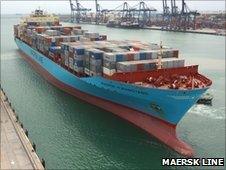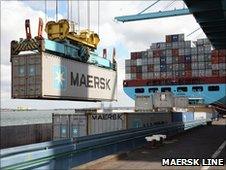Container shortage hits shipping lines
- Published

The rise in trade took ship owners by surprise
The recent and unexpected surge in international sea cargoes ought to be nothing but good news for the world's shipping lines. Yet the industry has hit an unexpected snag.
With trade between Asia and Europe already up almost a quarter, leading operators are warning of an acute shortage of those essential steel containers that are loaded onto ships and transferred to lorries at the world's docksides.
It appears demand for containers slumped so much during the bad economic times, that even the largest carriers failed to anticipate the recovery and order any more. At best they were expecting growth of about 1% this year.
As the peak cargo sailing season begins, operators admit they've been caught on the hop.
They've decided to make surcharges as they take idle vessels back into service and scrabble to lease extra containers to make up the shortfall from wherever they can.
Rates soar
Estimates from research company Tufton Oceanic suggest that 6 million new boxes are needed - that's equivalent to two years of production.
Most of the containers on the high seas are made in China. But Tom Leander, editor of the shipping journal Lloyd's List, says many manufacturers there are no longer geared up to respond rapidly to new orders.
"The factories essentially closed and we think many of the workers were hired elsewhere for other work under the China Stimulus Plan," he says.

Operators say it will be a while before shortages are met
"Then suddenly at the start of this year we saw a surge in volumes and the ship owners were taken by complete surprise. The fact that there are less boxes to ship has helped some freight rates to double since the beginning of the year."
One of the world's largest shipping lines, Maersk, insists it could not have forecast the turnaround - and admits things may get worse before they get better.
"We ourselves have placed a very large order for 120,000 containers, but it will take a little while for the factories to get on line," says Annemette Jepsen, managing director of Maersk Line UK.
"We have leased everything we can lay our hands on and we are also taking vessels out of lay- ups to feed the containers back to Asia to reduce the time they are tied up on land. It's not a planning error - we just couldn't have foreseen this."
Revamp
At some time in their lives, many containers end up coming up the Thames for repair or refurbishing at one of the giant marine container depots at Barking.
A cursory glance at the serried ranks of containers on the dockside might suggest it is just business as usual. But in fact, turnaround is quicker than ever.
Operators are working overtime to spruce up old containers which can then be leased or sold to meet the high demand. The idea is to get them back on a vessel and en route to Asia as soon as possible - ready for the annual surge of Christmas deliveries.
In some ways, operators have themselves to blame for their current predicament.
Only a few months ago, the immediate future for the industry remained bleak.
Most saw little prospect of profits for as much as five years - and responded by ruthlessly cutting spare capacity in their container fleets. De-stocking just seemed to make sense.
Now owners are trying to get back to the industry norm, which is having just over two containers available for every single slot on their ships
Much depends on the pace of orders for Christmas. Europe's debt crisis and continuing spending cuts could yet slow future imports from Asia.
But as things stand, Maersk sees the supply of boxes remaining tight until at least the autumn.